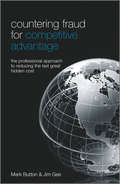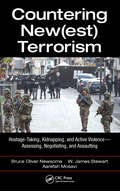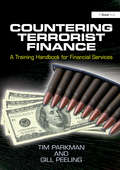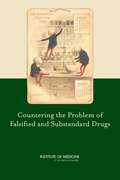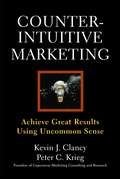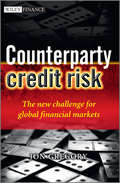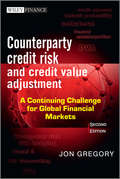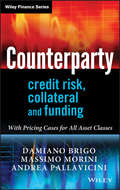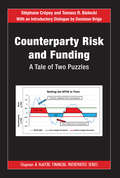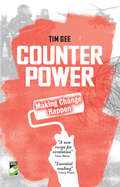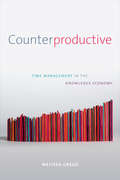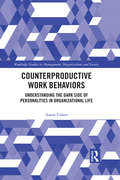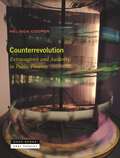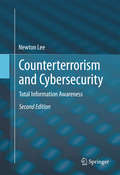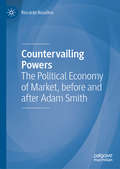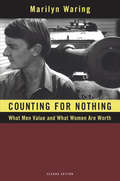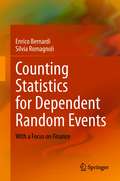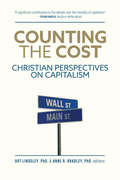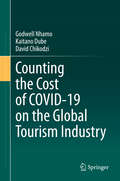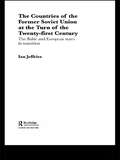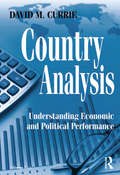- Table View
- List View
Countering Fraud for Competitive Advantage
by Jim Gee Mark ButtonSubstantially reduce the largely hidden cost of fraud, and reap a new competitive advantage. As the title suggests, Countering Fraud for Competitive Advantage presents a compelling business case for investing in anti-fraud measures to counter financial crime. It looks at the ways of reaping a new competitive advantage by substantially reducing the hidden cost of fraud. Aimed at a wide business community and based on solid research, it is the only book to put forward an evidence-based model for combating corporate fraud and financial crime. Despite its increase and capture of the news headlines, corporate fraud is largely ignored by most organizations. Fraud is responsible for losses of up to nine percent of revenues--sometimes more. Yet, most organizations don't believe they have a problem and don't always measure fraud losses. This highlights an area for capturing a competitive advantage--with the right counter-fraud strategy, massive losses due to the cost of fraud can be reduced for a fraction of the return. Advocates a new model for tackling fraud and illustrates theories with best practice examples from around the world The authors have close links with the Counter Fraud Professional Accreditation Board: Jim Gee is a world-renowned expert in the field, and has advised private companies and governments from more than 35 countries. Mark Button is Director of the leading Centre for Counter Fraud Studies, Portsmouth University, U.K. Organizations are losing millions of dollars to fraud. This book outlines a comprehensive approach to reducing financial crime and helping return some of the revenue lost to the cost of fraud.
Countering New(est) Terrorism: Hostage-Taking, Kidnapping, and Active Violence — Assessing, Negotiating, and Assaulting
by Bruce Oliver Newsome James W. Stewart Aarefah MosaviHow should we analyze and assess new terrorist behaviors? What are the particular risks and challenges from new terrorism? Should we negotiate with terrorists, and, if so, how? When should we use force against terrorists? Countering New(est) Terrorism: Hostage-Taking, Kidnapping, and Active Violence—Assessing, Negotiating, and Assaulting improves our knowledge of new terrorist behaviors, and our skills in responding to such attacks. The term "new terrorism" has been in circulation since the late 90’s. This book analyzes the "newest terrorism" that has emerged in recent years—characterized by increased hostage-taking, kidnapping, and active violence—and develops best practices for countering these emerging threats. Along the way, it challenges fashionable wishful thinking that all terrorists are open to rational negotiation or de-radicalization, that military responses always reflect badly on the official side, and that terrorists are not constrained by their own doctrines. The new terrorists are dramatically more ideological, murderous, and suicidal. They are generally less reconcilable, less trusting of official negotiators, less likely to release detainees, and more likely to kill detainees. They are less likely to demand ransoms yet more likely to release hostages in cases in which they do demand ransom. They are more informed about the official side’s policies, tactics, techniques, and procedures. They are more likely to use new information and communication technologies against responding agencies and officials. They are more capable fighters—they kill more people despite deploying fewer fighters per hostage. Most disturbing is the fact that they take advantage of free-er societies to access easier targets. Features: Includes evidence-based definitions and descriptions of political, religious, Jihadi, and new terrorism Presents the first large-n comparison of old and new terrorism, using an original extension of the Global Terrorism Database (GTD), with added codes for each of 10,735 hostage crises and more than 500,000 data points from 1970 through 2016 Details a further extension of the GTD covering all terrorist events from 2004 through 2016, roughly 5 million data points. Offers prescriptive advice and visual decision trees on how to negotiate crises, assess the risk of terrorism, and how and when to assault terrorists Reviews official practices, interviews with experienced officials, and real-world simulations of recent terrorist events and attacks Countering New(est) Terrorism will be of interest to researchers, students enrolled in terrorism and Homeland Security programs, crisis negotiators, and police, security, intelligence, and military authorities tasked with counterterrorism and anti-terrorism efforts.
Countering Terrorist Finance: A Training Handbook for Financial Services
by Tim Parkman Gill PeelingRegulation and control of the financial industry has become the weapon of choice for governments struggling to control the rise in global crime and terrorism. Tim Parkman and Gill Peeling's Countering Terrorist Finance - A Training Handbook for Financial Services is a practical, specialist guide for training staff in financial institutions in the processes and skills needed to respond to terrorist financing activities. The book explains international legal responses and obligations (with particular jurisdictional emphasis on the US, the UK, and Hong Kong); dissects the financing typologies behind terrorist attacks including September 11th, Madrid, Bali and other non al-Qaeda examples; analyzes potential causes for suspicion and offers an overview of the main issues and considerations affecting compliance professionals, in their efforts to protect against terrorist financing. The accompanying collection of eight training activities, with supporting materials and presentation slides, provides compliance officers with a resource for developing awareness and appropriate behaviour amongst employees tasked with managing terrorist finance risk. Additional training resource materials, including Powerpoint presentations, audio visual slideshows and pdf handouts are available on a CD ROM that accompanies the book. The background material, practical advice and training resources make this collection an excellent starting point for organizations striving to make a difference in this complex and difficult area.
Countering the Problem of Falsified and Substandard Drugs
by Lawrence O. GostinThe adulteration and fraudulent manufacture of medicines is an old problem, vastly aggravated by modern manufacturing and trade. In the last decade, impotent antimicrobial drugs have compromised the treatment of many deadly diseases in poor countries. More recently, negligent production at a Massachusetts compounding pharmacy sickened hundreds of Americans. While the national drugs regulatory authority (hereafter, the regulatory authority) is responsible for the safety of a country's drug supply, no single country can entirely guarantee this today. The once common use of the term counterfeit to describe any drug that is not what it claims to be is at the heart of the argument. In a narrow, legal sense a counterfeit drug is one that infringes on a registered trademark. The lay meaning is much broader, including any drug made with intentional deceit. Some generic drug companies and civil society groups object to calling bad medicines counterfeit, seeing it as the deliberate conflation of public health and intellectual property concerns. Countering the Problem of Falsified and Substandard Drugs accepts the narrow meaning of counterfeit, and, because the nuances of trademark infringement must be dealt with by courts, case by case, the report does not discuss the problem of counterfeit medicines.
Counterintuitive Marketing: Achieving Great Results Using Common Sense
by Kevin J. Clancy Peter C. KriegWhy does American business seem to sputter along where it ought to thrive? What is the source of the current plague of downsizing, disappearing companies, dot-com crashes, and here-today-gone-tomorrow advertising campaigns? Why do more products flop than ever before? Marketing experts Kevin J. Clancy and Peter C. Krieg have the answers. In Counterintuitive Marketing, Clancy and Krieg trace the high rate of business failure back to bad marketing strategy, and the even worse implementation of that strategy. Excess testosterone, they argue, compels senior managers to make decisions intuitively, instinctively, quickly, and, unfortunately, disastrously. In this informative and enlightening book, Clancy and Krieg confront these "over-and-over-again" marketers, who don't have time to do it right the first time, but endless time and a company bankroll to do it wrong over and over again. The authors draw from their decades of consumer and business-to-business marketing experience to describe the intuitive decision-making practices that permeate business today, and demonstrate how these practices lead to disappointing performance. Chapter by chapter, Counterintuitive Marketing contrasts how marketing decisions are made today with how they should be made. The authors give equal treatment to targeting, positioning, product development, pricing, customer service, e-commerce, marketing planning, implementation, and more as they present counterintuitive ideas for building and introducing blockbuster marketing programs. Readers will discover in this iconoclastic treasure chest hundreds of penetrating insights that have enabled the authors' firm, Copernicus, to transform companies and become a "brand guardian" to the Fortune 500 and emerging businesses around the world. The tools to create exceptional marketing programs really do exist, and they are all here in Counterintuitive Marketing, the ultimate practical guide for any company of any size.
Counternetwork: Countering the Expansion of Transnational Criminal Networks
by Angel Rabasa Christopher M. Schnaubelt Douglas Farah Gregory Midgette Howard J. Shatz Peter ChalkThrough an analysis of transnational criminal networks originating in South America, this report presents operational characteristics of these networks, strategic alliances they have established, and the multiple threats that they pose to U.S. interests and to the stability of the countries where they operate. It also identifies U.S. government policies and programs to counter these networks and examines the military’s role in that context.
Counterparty Credit Risk
by Jon GregoryThe first decade of the 21st Century has been disastrous for financial institutions, derivatives and risk management. Counterparty credit risk has become the key element of financial risk management, highlighted by the bankruptcy of the investment bank Lehman Brothers and failure of other high profile institutions such as Bear Sterns, AIG, Fannie Mae and Freddie Mac. The sudden realisation of extensive counterparty risks has severely compromised the health of global financial markets. Counterparty risk is now a key problem for all financial institutions. This book explains the emergence of counterparty risk during the recent credit crisis. The quantification of firm-wide credit exposure for trading desks and businesses is discussed alongside risk mitigation methods such as netting and collateral management (margining). Banks and other financial institutions have been recently developing their capabilities for pricing counterparty risk and these elements are considered in detail via a characterisation of credit value adjustment (CVA). The implications of an institution valuing their own default via debt value adjustment (DVA) are also considered at length. Hedging aspects, together with the associated instruments such as credit defaults swaps (CDSs) and contingent CDS (CCDS) are described in full. A key feature of the credit crisis has been the realisation of wrong-way risks illustrated by the failure of monoline insurance companies. Wrong-way counterparty risks are addressed in detail in relation to interest rate, foreign exchange, commodity and, in particular, credit derivative products. Portfolio counterparty risk is covered, together with the regulatory aspects as defined by the Basel II capital requirements. The management of counterparty risk within an institution is also discussed in detail. Finally, the design and benefits of central clearing, a recent development to attempt to control the rapid growth of counterparty risk, is considered. This book is unique in being practically focused but also covering the more technical aspects. It is an invaluable complete reference guide for any market practitioner with any responsibility or interest within the area of counterparty credit risk.
Counterparty Credit Risk and Credit Value Adjustment
by Jon GregoryA practical guide to counterparty risk management and credit value adjustment from a leading credit practitionerSince the collapse of Lehman Brothers and the resultant realization of extensive counterparty risk across the global financial markets, the subject of counterparty risk has become an unavoidable issue for every financial institution. This book explains the emergence of counterparty risk and how financial institutions are developing capabilities for valuing it. It also covers portfolio management and hedging of credit value adjustment, debit value adjustment, and wrong-way counterparty risks. In addition, the book addresses the design and benefits of central clearing, a recent development in attempts to control the rapid growth of counterparty risk. This uniquely practical resource serves as an invaluable guide for market practitioners, policy makers, academics, and students.
Counterparty Credit Risk, Collateral and Funding
by Andrea Pallavicini Damiano Brigo Massimo MoriniThe book's content is focused on rigorous and advanced quantitative methods for the pricing and hedging of counterparty credit and funding risk. The new general theory that is required for this methodology is developed from scratch, leading to a consistent and comprehensive framework for counterparty credit and funding risk, inclusive of collateral, netting rules, possible debit valuation adjustments, re-hypothecation and closeout rules. The book however also looks at quite practical problems, linking particular models to particular 'concrete' financial situations across asset classes, including interest rates, FX, commodities, equity, credit itself, and the emerging asset class of longevity.The authors also aim to help quantitative analysts, traders, and anyone else needing to frame and price counterparty credit and funding risk, to develop a 'feel' for applying sophisticated mathematics and stochastic calculus to solve practical problems.The main models are illustrated from theoretical formulation to final implementation with calibration to market data, always keeping in mind the concrete questions being dealt with. The authors stress that each model is suited to different situations and products, pointing out that there does not exist a single model which is uniformly better than all the others, although the problems originated by counterparty credit and funding risk point in the direction of global valuation.Finally, proposals for restructuring counterparty credit risk, ranging from contingent credit default swaps to margin lending, are considered.
Counterparty Risk and Funding: A Tale of Two Puzzles (Chapman and Hall/CRC Financial Mathematics Series #31)
by Stéphane Crépey Tomasz R. Bielecki Damiano BrigoSolve the DVA/FVA Overlap Issue and Effectively Manage Portfolio Credit Risk Counterparty Risk and Funding: A Tale of Two Puzzles explains how to study risk embedded in financial transactions between the bank and its counterparty. The authors provide an analytical basis for the quantitative methodology of dynamic valuation, mitigation, and hedging of bilateral counterparty risk on over-the-counter (OTC) derivative contracts under funding constraints. They explore credit, debt, funding, liquidity, and rating valuation adjustment (CVA, DVA, FVA, LVA, and RVA) as well as replacement cost (RC), wrong-way risk, multiple funding curves, and collateral. The first part of the book assesses today’s financial landscape, including the current multi-curve reality of financial markets. In mathematical but model-free terms, the second part describes all the basic elements of the pricing and hedging framework. Taking a more practical slant, the third part introduces a reduced-form modeling approach in which the risk of default of the two parties only shows up through their default intensities. The fourth part addresses counterparty risk on credit derivatives through dynamic copula models. In the fifth part, the authors present a credit migrations model that allows you to account for rating-dependent credit support annex (CSA) clauses. They also touch on nonlinear FVA computations in credit portfolio models. The final part covers classical tools from stochastic analysis and gives a brief introduction to the theory of Markov copulas. The credit crisis and ongoing European sovereign debt crisis have shown the importance of the proper assessment and management of counterparty risk. This book focuses on the interaction and possible overlap between DVA and FVA terms. It also explores the particularly challenging issue of counterparty risk in portfolio credit modeling. Primarily for researchers and graduate students in financial mathematics, the book is also suitable for financial quants, managers in banks, CVA desks, and members of supervisory bodies.
Counterparty Risk, Impact on Collateral Flows and Role for Central Counterparties
by Manmohan Singh James AitkenA report from the International Monetary Fund.
Counterparty Risk in the Over-The-Counter Derivatives Market
by Miguel A. Segoviano Manmohan SinghA report from the International Monetary Fund.
Counterpower
by Tim GeeThis timely book argues that no major movement has ever been successful without counterpower, or the power that the "have-nots" can use to remove the power of the "haves." Investigating the history and tactics of major movements of the past and today's global justice and human rights movements, Tim Gee demonstrates what works and what doesn't work. In showing how counterpower can be strategically applied, Gee has created an inspiration for activists and an invaluable resource for teachers and students of social change. Tim Gee is a writer and communications specialist working with campaigning organizations in the United Kingdom and worldwide.
Counterproductive: Time Management in the Knowledge Economy
by Melissa GreggAs online distractions increasingly colonize our time, why has productivity become such a vital demonstration of personal and professional competence? When corporate profits are soaring but worker salaries remain stagnant, how does technology exacerbate the demand for ever greater productivity? In Counterproductive Melissa Gregg explores how productivity emerged as a way of thinking about job performance at the turn of the last century and why it remains prominent in the different work worlds of today. Examining historical and archival material alongside popular self-help genres—from housekeeping manuals to bootstrapping business gurus, and the growing interest in productivity and mindfulness software—Gregg shows how a focus on productivity isolates workers from one another and erases their collective efforts to define work limits. Questioning our faith in productivity as the ultimate measure of success, Gregg's novel analysis conveys the futility, pointlessness, and danger of seeking time management as a salve for the always-on workplace.
Counterproductive Work Behaviors: Understanding the Dark Side of Personalities in Organizational Life (Routledge Studies in Management, Organizations and Society)
by Aaron CohenThere has been a growing interest among scholars in the fields of organizational behaviour and industrial psychology in what can be termed "the dark side of the organizations." A main concept in this regard this is both important and relevant counterproductive work behaviours (CWBs), which can be defined as deliberate actions that harm the organization or its members. These behaviours include a variety of acts that can be directed toward organizations (CWB-O) or toward other people (CWB-P). Destroying organizational property, purposely doing work incorrectly, and taking unauthorized work breaks are examples of CWB-O, whereas hitting a co-worker, insulting others, and shouting at someone are forms of CWB-P. Despite the growing interest in CWBs as a research issue, not enough is known about the determinants of CWBs. The goal of Counterproductive Work Behaviors therefore is to cover this stimulating, important, and innovative issue of dark triad personalities in the workplace. The book will deal with important aspects of this issue, such as the characteristics of dark triad personalities, how they operate and damage organizations, what organizations are more vulnerable to them, ways to diagnose and detect them, and ways to handle dark triad personalities and prevent them from harming organizations and employees. There is no doubt that the issues covered by Counterproductive Work Behaviors will continue to attract academic attention and therefore the book is essential reading for researchers, academics and business professionals alike in the fields of Organizational Studies and Behaviour, Organizational Psychology, Strategy, Human Resource Management, Leadership and the related disciplines.
Counterrevolution: Extravagance and Austerity in Public Finance
by Melinda CooperA thorough investigation of the current combination of austerity and extravagance that characterizes government spending and central bank monetary policyAt the close of the 1970s, government treasuries and central banks took a vow of perpetual self-restraint. To this day, fiscal authorities fret over soaring public debt burdens, while central bankers wring their hands at the slightest sign of rising wages. As the brief reprieve of coronavirus spending made clear, no departure from government austerity will be tolerated without a corresponding act of penance.Yet we misunderstand the scope of neoliberal public finance if we assume austerity to be its sole setting. Beyond the zero-sum game of direct claims on state budgets lies a realm of indirect government spending that escapes the naked eye. Capital gains are multiply subsidized by a tax system that reserves its greatest rewards for financial asset holders. And for all its airs of haughty asceticism, the Federal Reserve has become adept at facilitating the inflation of asset values while ruthlessly suppressing wages. Neoliberalism is as extravagant as it is austere, and this paradox needs to be grasped if we are to challenge its core modus operandi.Melinda Cooper examines the major schools of thought that have shaped neoliberal common sense around public finance. Focusing, in particular, on Virginia school public choice theory and supply-side economics, she shows how these currents produced distinct but ultimately complementary responses to the capitalist crisis of the 1970s. With its intellectual roots in the conservative Southern Democratic tradition, Virginia school public choice theory espoused an austere doctrine of budget balance. The supply-side movement, by contrast, advocated tax cuts without spending restraint and debt issuance without guilt, in an apparent repudiation of austerity. Yet, for all their differences, the two schools converged around the need to rein in the redistributive uses of public spending. Together, they drove a counterrevolution in public finance that deepened the divide between rich and poor and revived the fortunes of dynastic wealth.Far-reaching as the neoliberal counterrevolution has been, Cooper still identifies a counterfactual history of unrealized possibilities in the capitalist crisis of the 1970s. She concludes by inviting us to rethink the concept of revolution and raises the question: Is another politics of extravagance possible?
Counterterrorism and Cybersecurity: Total Information Awareness
by Newton LeeImagine James Bond meets Sherlock Holmes: Counterterrorism and Cybersecurity is the sequel to Facebook Nation in the Total Information Awareness book series by Newton Lee. The book examines U.S. counterterrorism history, technologies, and strategies from a unique and thought-provoking approach that encompasses personal experiences, investigative journalism, historical and current events, ideas from great thought leaders, and even the make-believe of Hollywood. Demystifying Total Information Awareness, the author expounds on the U.S. intelligence community, artificial intelligence in data mining, social media and privacy, cyber attacks and prevention, causes and cures for terrorism, and longstanding issues of war and peace. The book offers practical advice for businesses, governments, and individuals to better secure the world and protect cyberspace. It quotes U.S. Navy Admiral and NATO's Supreme Allied Commander James Stavridis: "Instead of building walls to create security, we need to build bridges." The book also provides a glimpse into the future of Plan X and Generation Z, along with an ominous prediction from security advisor Marc Goodman at TEDGlobal 2012: "If you control the code, you control the world." Counterterrorism and Cybersecurity: Total Information Awareness will keep you up at night but at the same time give you some peace of mind knowing that "our problems are manmade -- therefore they can be solved by man [or woman]," as President John F. Kennedy said at the American University commencement in June 1963.
Countervailing Powers: The Political Economy of Market, before and after Adam Smith
by Riccardo RosolinoThis book will trace the trajectory of the surprising idea that the victims of monopolistic conspiracies should be allowed to fight back using the same fraudulent and immoral weapons as the conspirators. In other words, if left to itself, the market will produce the antibodies necessary to survival, notwithstanding its most sinister pathology – the tendency of its principals to conclude private agreements behind the scenes.Originally conceived in a moral context halfway through the 16th century, the idea was then taken over by the world of commercial law in exactly the form it had been employed theologically. Surprisingly, though, after doing the rounds for over a century, it then disappeared without trace. This book will look at how Adam Smith revived and recharged the idea. He applied it in The Wealth of Nations (1776) to the conflict of interest between employers and workers in the attempt to break the stranglehold of the artificial compression of wages to minimum subsistence level. After Smith, the freshly revived idea went underground again for another half-century until, in the 1820s, it assumed a front-row position in the newborn liberal political economics. This book will look at how, in the framework of the debate over the repeal of the Combination Laws, the idea was dusted down and put back in the fight, having first been stripped it off its moral clothes and dressed instead in the new robes of economic pragmatism.
Counting for Nothing
by Marilyn WaringSafe drinking water counts for nothing. A pollution-free environment counts for nothing. Even some people - namely women - count for nothing. This is the case, at least, according to the United Nations System of National Accounts. Author Marilyn Waring, former New Zealand M.P., now professor, development consultant, writer, and goat farmer, isolates the gender bias that exists in the current system of calculating national wealth.As Waring observes, in this accounting system women are considered 'non-producers' and as such they cannot expect to gain from the distribution of benefits that flow from production. Issues like nuclear warfare, environmental conservation, and poverty are likewise excluded from the calculation of value in traditional economic theory. As a result, public policy, determined by these same accounting processes, inevitably overlooks the importance of the environment and half the world's population.Counting for Nothing, originally published in 1988, is a classic feminist analysis of women's place in the world economy brought up to date in this reprinted edition, including a sizeable new introduction by the author. In her new introduction, the author updates information and examples and revisits the original chapters with appropriate commentary. In an accessible and often humorous manner, Waring offers an explanation of the current economic systems of accounting and thoroughly outlines ways to ensure that the significance of the environment and the labour contributions of women receive the recognition they deserve.
Counting Statistics for Dependent Random Events: With a Focus on Finance
by Enrico Bernardi Silvia RomagnoliThis book on counting statistics presents a novel copula-based approach to counting dependent random events. It combines clustering, combinatorics-based algorithms and dependence structure in order to tackle and simplify complex problems, without disregarding the hierarchy of or interconnections between the relevant variables. These problems typically arise in real-world applications and computations involving big data in finance, insurance and banking, where experts are confronted with counting variables in monitoring random events.In this new approach, combinatorial distributions of random events are the core element. In order to deal with the high-dimensional features of the problem, the combinatorial techniques are used together with a clustering approach, where groups of variables sharing common characteristics and similarities are identified and the dependence structure within groups is taken into account. The original problems can then be modeled using new classes of copulas, referred to here as clusterized copulas, which are essentially based on preliminary groupings of variables depending on suitable characteristics and hierarchical aspects.The book includes examples and real-world data applications, with a special focus on financial applications, where the new algorithms’ performance is compared to alternative approaches and further analyzed. Given its scope, the book will be of interest to master students, PhD students and researchers whose work involves or can benefit from the innovative methodologies put forward here. It will also stimulate the empirical use of new approaches among professionals and practitioners in finance, insurance and banking.
Counting the Cost: Christian Perspectives on Capitalism
by Art LindsleyIf Christians want to accelerate the world’s transition out of abject poverty, they need to examine the role of capitalism.Counting the Cost helps readers begin with the truth of Scripture. It then relies on the economic realities that come from our Godgiven design as the foundation for enabling readers to think critically about capitalism.We live in an unprecedented time in human history. The number of people living in abject poverty is decreasing at an unprecedented rate. Capitalism has played a major role in lifting people out of such poverty, yet many raise legitimate concerns. Does capitalism hurt the poor? Promote materialism? Harm the environment? Allow the rich to get richer at the expense of everyone else? Is capitalism really the best system for organizing societies and the economies that keep them running?This edited volume of articles by noted economists and theologians takes an honest and empathetic look at capitalism and its critiques from a biblical perspective.
Counting the Cost of COVID-19 on the Global Tourism Industry
by Godwell Nhamo Kaitano Dube David ChikodziThis book profiles preliminary findings on the impact of COVID-19 on the travel, tourism and hospitality sector. Starting with a narrative relating COVID-19 to the global development agendas, the book proceeds with a focus on global tourism value chains and linkages between COVID-19 and the Sustainable Development Goals (SDGs). Other perspectives addressed in separate chapters include impacts of COVID-19 on various industries within the global tourism value chain including aviation, airports, cruise ships, car rentals as well as ride and share car services, hotels, restaurants, sporting, pilgrimage and religious tourism, gaming and entertainment, and the stock market. The book also includes chapters on corporate, philanthropic and public donations, as well as tourism economic stimulus packages. It then concludes with a chapter focusing on building back a better tourism sector post-COVID-19 that strongly draws from the Sendai Framework on Disaster Risk Reduction (2015-2030) and the disaster cycle. To this end, this book is suitable as a read for several professionals in disciplines such as tourism and hospitality studies, economics, sustainable development, development studies, environmental sciences, geography, politics, planning and public health.
The Countries of the Former Soviet Union at the Turn of the Twenty-First Century: The Baltic and European States in Transition (Routledge Studies Of Societies In Transition Ser.)
by Ian JeffriesOffering a unique level of coverage, this book provides a comprehensive survey of the political and economic development of the countries of the former Soviet Union from the mid-1990s onwards.
Country Analysis: Understanding Economic and Political Performance
by David M. CurrieThe ability to connect theoretical macroeconomics to the analysis of the economic and political performance of a given country is an essential skill for global investors. In Country Analysis: Understanding Economic and Political Performance, David M. Currie takes a unique analytical approach to the subject, clearly demonstrating the relationship between theory and application in investing practices. This valuable book shows how to interpret country performance and provides the practising investor with sufficient background on economic principles to be able to understand and interpret country summaries that appear in business periodicals and other media. It covers key topics such as the Washington Consensus and the three major categories of economic decisions - fiscal policy, monetary policy and trade policy. It includes an important chapter on the political aspect of government performance, to give the reader an understanding of economic decisions in their true context. Country Analysis explains the reasoning behind the criteria used in evaluating country risk and economic performance, without the need for a sophisticated understanding of economics or mathematics. Each chapter includes a series of text boxes that include real-life examples from business periodicals to reinforce what is discussed and enable readers to practice identifying and interpreting relevant information. Practitioners making investment decisions in global markets, as well as students in MBA and other courses, will find this immensely practical book a valuable aid to critical decision making.
Country Analysis: A Framework to Identify and Evaluate the National Business Environment
by Alexander DyckA manager's ability to build profitable firms depends upon the business environment within which firms interact. This note presents a framework to help understand, anticipate, and perhaps foster changes in the business environment. Describes building a picture of the business environment as country analysis. The country analysis framework has three interdependent components of strategy, context, and performance. Focuses on identifying and evaluating the national and international context. In particular, clarifies the role state actors, nonfirm organizations, and "rules of the game" can play in firm decision making.
